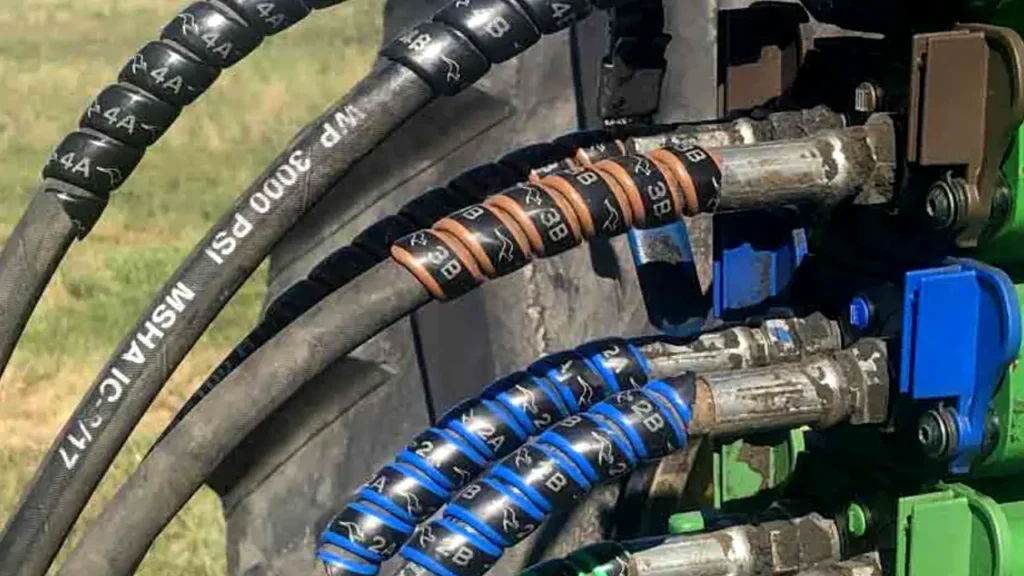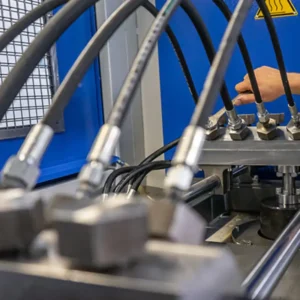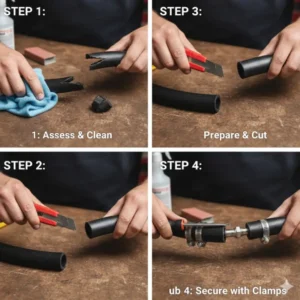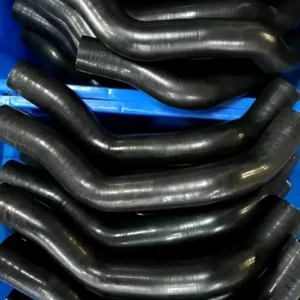Properly hooking up hydraulic hoses to your tractor is essential for efficient and safe operation. A well-connected hydraulic system ensures smooth functioning of various attachments and implements.
In this guide, we’ll walk you through the steps involved in connecting hydraulic hoses to your tractor, providing clear instructions and safety tips. Whether you’re a seasoned farmer or a novice, this guide will help you master the process.
Why Hooking Up Hydraulic Hoses
Hydraulic hoses are essential components in many mechanical systems, including tractors, construction equipment, and industrial machinery. They are responsible for transmitting hydraulic fluid under pressure, which powers various operations such as lifting, digging, and cutting.
Here’s why hooking up hydraulic hoses is crucial:
Power Transmission:
- Hydraulic hoses efficiently transmit hydraulic fluid from the pump to hydraulic actuators (like cylinders and motors).
- This fluid, under pressure, provides the necessary force to operate these components.
Flexibility and Maneuverability:
- Hydraulic hoses offer flexibility, allowing for the movement of equipment and attachments in various directions.
- They can be routed around obstacles and accommodate different configurations.
Remote Control:
- Hydraulic hoses enable remote control of equipment, allowing operators to control machinery from a safe distance.
Precision Control:
- Hydraulic systems provide precise control over equipment, allowing for delicate tasks like fine adjustments and precise movements.
Efficiency and Productivity:
- Well-maintained hydraulic systems, including properly connected hoses, can significantly improve the efficiency and productivity of machinery.
By understanding the importance of hydraulic hoses, you can appreciate the role they play in various industries and the benefits they provide in terms of power, flexibility, and control.
How to Hook Up Hydraulic Hoses on a Tractor

Safety First:
- Relieve Pressure: Ensure the hydraulic system is depressurized to prevent accidental fluid ejection.
- Wear Protective Gear: Use gloves and safety glasses to protect yourself from potential injuries.
- Cleanliness: Clean the connection points to remove dirt and debris that could damage the seals.
Step-by-Step Guide:
- Identify the Connections:
- Locate the hydraulic couplers on the tractor and the implement. These are typically quick-connect fittings.
- Ensure the couplers are compatible in terms of size and type.
- Align the Couplers:
- Position the male and female couplers so they align correctly.
- Connect the Hoses:
- Push the male coupler firmly into the female coupler until it locks into place. You should hear a distinct click or feel a firm connection.
- Avoid forcing the connection, as this could damage the couplers.
- Check for Leaks:
- Visually inspect the connections for any signs of leaks, such as fluid dripping or misting.
- If you notice any leaks, re-tighten the connections or replace any damaged components.
Additional Tips:
- Consult Your Tractor’s Manual: Refer to your tractor’s owner’s manual for specific instructions and diagrams.
- Use the Right Tools: If necessary, use tools like wrenches or pliers to tighten fittings securely.
- Avoid Kinking Hoses: Ensure the hoses are routed correctly to prevent kinking, which can restrict fluid flow and damage the hose.
- Regular Maintenance: Periodically inspect hydraulic hoses for wear and tear, and replace them as needed.
By following these steps and prioritizing safety, you can successfully hook up hydraulic hoses on your tractor.
Remember: If you’re unsure about any part of the process, consult a qualified mechanic or refer to your tractor’s manual.
How to Hook Up Hydraulic Hoses on a John Deere

Safety First:
- Relieve Pressure: Always ensure the hydraulic system is depressurized to prevent accidental fluid ejection.
- Wear Protective Gear: Use gloves and safety glasses to protect yourself from potential injuries.
- Cleanliness: Clean the connection points to remove dirt and debris that could damage the seals.
Step-by-Step Guide:
- Identify the Connections:
- Locate the hydraulic couplers on the tractor and the implement. These are typically quick-connect fittings.
- Ensure the couplers are compatible in terms of size and type.
- Align the Couplers:
- Position the male and female couplers so they align correctly.
- Connect the Hoses:
- Push the male coupler firmly into the female coupler until it locks into place. You should hear a distinct click or feel a firm connection.
- Avoid forcing the connection, as this could damage the couplers.
- Check for Leaks:
- Visually inspect the connections for any signs of leaks, such as fluid dripping or misting.
- If you notice any leaks, re-tighten the connections or replace any damaged components.
Additional Tips for John Deere Tractors:
- Consult Your Owner’s Manual: Refer to your specific John Deere tractor’s manual for detailed instructions and diagrams.
- Use Genuine John Deere Parts: Using genuine John Deere parts ensures compatibility and reliability.
- Be Mindful of Hydraulic Fluid: Avoid spilling hydraulic fluid, as it can damage surfaces and harm the environment.
- Regular Maintenance: Periodically inspect hydraulic hoses for wear and tear, and replace them as needed.
Remember: If you’re unsure about any part of the process, consult a qualified mechanic or your local John Deere dealer.
Visual Guide:
While a visual guide can be extremely helpful, it’s essential to refer to your specific tractor’s manual for accurate instructions. You may also find helpful videos on platforms like YouTube that demonstrate the process for your particular John Deere model.
By following these steps and prioritizing safety, you can successfully hook up hydraulic hoses on your John Deere tractor.
How to Hook Up Hydraulic Hoses on a Skid Steer

Safety First:
- Relieve Pressure: Always ensure the hydraulic system is depressurized to prevent accidental fluid ejection.
- Wear Protective Gear: Use gloves and safety glasses to protect yourself from potential injuries.
- Cleanliness: Clean the connection points to remove dirt and debris that could damage the seals.
Step-by-Step Guide:
- Identify the Connections:
- Locate the hydraulic couplers on the skid steer and the attachment. These are typically quick-connect fittings.
- Ensure the couplers are compatible in terms of size and type.
- Align the Couplers:
- Position the male and female couplers so they align correctly.
- Connect the Hoses:
- Push the male coupler firmly into the female coupler until it locks into place. You should hear a distinct click or feel a firm connection.
- Avoid forcing the connection, as this could damage the couplers.
- Check for Leaks:
- Visually inspect the connections for any signs of leaks, such as fluid dripping or misting.
- If you notice any leaks, re-tighten the connections or replace any damaged components.
Additional Tips:
- Consult Your Owner’s Manual: Refer to your skid steer’s owner’s manual for specific instructions and diagrams.
- Use the Right Tools: If necessary, use tools like wrenches or pliers to tighten fittings securely.
- Avoid Kinking Hoses: Ensure the hoses are routed correctly to prevent kinking, which can restrict fluid flow and damage the hose.
- Regular Maintenance: Periodically inspect hydraulic hoses for wear and tear, and replace them as needed.
By following these steps and prioritizing safety, you can successfully hook up hydraulic hoses on your skid steer.
Remember: If you’re unsure about any part of the process, consult a qualified mechanic or your equipment’s manual.
Visual Guide: While a visual guide can be extremely helpful, it’s essential to refer to your specific skid steer’s manual for accurate instructions. You may also find helpful videos on platforms like YouTube that demonstrate the process for your particular skid steer model.
By following these steps and prioritizing safety, you can successfully hook up hydraulic hoses on your skid steer.
How to Hook Up Hydraulic Hoses on a Bobcat
Safety First:
- Relieve Pressure: Always ensure the hydraulic system is depressurized to prevent accidental fluid ejection.
- Wear Protective Gear: Use gloves and safety glasses to protect yourself from potential injuries.
- Cleanliness: Clean the connection points to remove dirt and debris that could damage the seals.
Step-by-Step Guide:
- Identify the Connections:
- Locate the hydraulic couplers on the Bobcat and the attachment. These are typically quick-connect fittings.
- Ensure the couplers are compatible in terms of size and type.
- Align the Couplers:
- Position the male and female couplers so they align correctly.
- Connect the Hoses:
- Push the male coupler firmly into the female coupler until it locks into place. You should hear a distinct click or feel a firm connection.
- Avoid forcing the connection, as this could damage the couplers.
- Check for Leaks:
- Visually inspect the connections for any signs of leaks, such as fluid dripping or misting.
- If you notice any leaks, re-tighten the connections or replace any damaged components.
Additional Tips:
- Consult Your Owner’s Manual: Refer to your Bobcat’s owner’s manual for specific instructions and diagrams.
- Use the Right Tools: If necessary, use tools like wrenches or pliers to tighten fittings securely.
- Avoid Kinking Hoses: Ensure the hoses are routed correctly to prevent kinking, which can restrict fluid flow and damage the hose.
- Regular Maintenance: Periodically inspect hydraulic hoses for wear and tear, and replace them as needed.
By following these steps and prioritizing safety, you can successfully hook up hydraulic hoses on your Bobcat.
Remember: If you’re unsure about any part of the process, consult a qualified mechanic or your equipment’s manual.
Visual Guide: While a visual guide can be extremely helpful, it’s essential to refer to your specific Bobcat’s manual for accurate instructions. You may also find helpful videos on platforms like YouTube that demonstrate the process for your particular Bobcat model.
By following these steps and prioritizing safety, you can successfully hook up hydraulic hoses on your Bobcat.
Conclusion
Hooking up hydraulic hoses on a tractor can be a straightforward task when done correctly. By following the steps outlined in this guide, you can ensure a secure and leak-free connection. Remember to prioritize safety, use the right tools, and consult your tractor’s manual for specific instructions.
Need high-quality hydraulic hoses for your next project?
Gushan Rubber offers a wide range of wholesale hydraulic hoses to meet your specific needs. Our hoses are built to withstand demanding conditions and ensure optimal performance.
Contact us today to learn more about our products and services.




